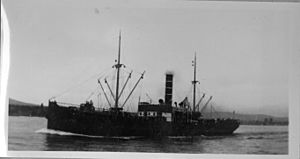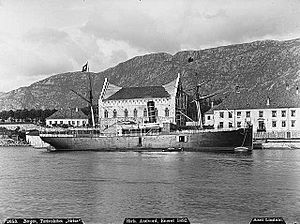SS Sirius (1885) facts for kids

Sirius near Oslo
|
|
Quick facts for kids History |
|
|---|---|
| Name | Sirius |
| Namesake | The star Sirius |
| Owner | Bergen Steamship Company |
| Port of registry | Bergen |
| Route |
|
| Builder | Flensburger Schiffbau-Gesellschaft, Flensburg, Germany |
| Cost | 350,435 kr |
| Yard number | 76 |
| Launched | 26 February 1885 |
| Completed | April 1885 |
| Identification | |
| Fate | Sunk by a Luftwaffe bomber off Finnlandsneset, Dyrøya, on 18 May 1940 |
| General characteristics | |
| Type |
|
| Tonnage |
|
| Length |
|
| Beam |
|
| Draught |
|
| Installed power |
|
| Propulsion |
|
| Speed | 10 knots (19 km/h; 12 mph) |
| Capacity | 70 passengers (before 1927 cargo ship conversion) |
| Crew | 18 (1940) |
The SS Sirius was a Norwegian steamship built in Germany in 1885. This ship, made of iron, sailed for over 55 years. It carried goods, regular passengers, and tourists between Norway and other parts of Europe. It also sailed along the coast of Norway.
For one year, from 1894 to 1895, Sirius was part of the famous Hurtigruten route. This route connects many towns along the Norwegian coast. After that, it went back to its usual jobs. Sirius was rebuilt two times. The last rebuild in 1927 changed it into a ship that only carried cargo. It did this job for the rest of its life.
In 1940, Germany invaded Norway. The Norwegian government took control of Sirius. The ship then helped carry supplies for both civilians and the military. On May 18, 1940, a German aircraft bombed and sank Sirius.
Contents
Building the Sirius
The ship Sirius was built in Flensburg, Germany. It was made at the Flensburger Schiffbau-Gesellschaft shipyard. The ship was launched on February 26, 1885. It was an iron-hulled steamship and weighed about 877 tons.
Sirius had a special deck on top called a "hurricane" or awning deck. It was powered by a steam engine with 700 horsepower. This engine allowed it to travel at a speed of 10 knots (about 18.5 kilometers per hour). The ship was 191.2 feet (58.3 meters) long. It was 28.8 feet (8.8 meters) wide and had a depth of 20 feet (6.1 meters) in the water.
The ship was finished in April 1885. It was given to the Bergen Steamship Company in Bergen, Norway. Building Sirius cost 350,435 Norwegian kroner. It was one of four ships bought by the company around that time. They needed new ships to replace their older ones.
Sirius could carry 70 passengers. It had three different passenger classes. There were 24 cabins for First Class, 22 for Second Class, and 24 for Third Class. The passenger areas were on the main deck. The cargo holds, where goods were stored, were at the front and back of the engine room.
The ship was named after the star Sirius. This was a tradition for the Bergen Steamship Company. They often named their ships after objects in the sky.
Early Journeys
The Bergen Steamship Company first used Sirius to carry passengers and cargo. It sailed between different ports in Norway and the German city of Hamburg. It traveled to Norwegian ports from Kristiansand in the south to Vadsø in the far north.
During the summer, Sirius also carried tourists. In 1890, Sirius met the German royal yacht Hohenzollern I. This yacht was carrying Emperor Wilhelm II on one of his trips to Norway. As the two ships passed near Kristiansund, Sirius raised its flag. It also fired a salute gun to honor the German emperor.
In 1890, a big fire destroyed much of the port city of Hammerfest. The Norwegian government sent Sirius from Tromsø to help. It carried 50 barrels of bread, butter, coffee, and flour as emergency aid.
Hurtigruten Service
In 1894, the Bergen Steamship Company and another company, Nordenfjeldske Dampskibsselskab, got a joint contract. They were to sail the Hurtigruten coastal route for four years. This route was started a year earlier by businessman Richard With.
The first journey for this new plan started on July 3, 1894. Sirius sailed north from Trondheim. In summer, the route carried goods and people between Trondheim and Hammerfest. In winter, it only went as far north as Tromsø.
Sirius finished its time on the Hurtigruten route on July 1, 1895. Then, Nordenfjeldske took over as planned. While on the Hurtigruten service, Sirius left Trondheim every Thursday at 8:00 AM.

Passenger, Cargo, and Tourist Trips
After its year on the Hurtigruten route, Sirius went back to its Hamburg-Norway route. Every spring, the ship was taken out of service for cleaning and repairs. Then, in the summer, it was used as a tourist cruise ship along the coast of Norway.
In 1896, Sirius had electric lights installed. In 1898, it sometimes filled in on the route from Bergen to Newcastle in England. This happened when other ships needed maintenance.
1908 Rebuild and Continued Journeys
In 1908, Sirius was taken out of service for a major rebuild. The work was done in Bergen. Its length was increased to 207.5 feet (63.2 meters). During this rebuild, its old two-cylinder steam engine was replaced. A new, more powerful 950 horsepower engine was installed.
After the rebuild, Sirius continued its passenger and cargo routes. It also started a new route between Norway and Iceland. The route between Hamburg and Norway was stopped during World War I (1914–1918). It started again in 1918, but with fewer trips. By 1918, Sirius was an old ship. Newer ships replaced it on the passenger routes.
Becoming a Cargo Ship
In 1927, Sirius had more rebuilding work done. This work cost 108,000 Norwegian kroner. All its passenger areas were removed. The ship was changed to carry only cargo. Twelve cabins were kept, but they were not used for regular passengers. As a cargo ship, it weighed 944 tons.
For the rest of its life, Sirius carried cargo. It sailed between Oslo, the capital city of Norway, and Finnmark, Norway's northernmost county. By 1930, it had the code letters JVTL and a wireless radio. In 1934, the code letters were changed to LEUS. They stayed that way until the ship was sunk.
World War II and Sinking
German Invasion
On April 9, 1940, Germany invaded neutral Norway. At that time, Sirius was in Northern Norway. The day before the invasion, it had left Narvik and was heading to Tromsø.
The Norwegian government took control of Sirius and other ships. They needed them to help fight against the Germans. Sirius became a supply ship. It carried goods for both the local government and the military in Northern Norway. The Norwegian government took control of 30 ships during the fighting. Six of these ships were sunk by the Germans.
The Sinking of Sirius
On May 18, 1940, Sirius was sailing from Tromsø to Risøyhamn. It was going to pick up some civilian vehicles that the military needed. The ship was empty of cargo, having just unloaded hay at Røsneshavn. It had left Røsneshavn on the morning of May 17.
Sirius was told to sail far from the coast. But due to a misunderstanding, it sailed close to the shore. German bombers often patrolled this area. In the late evening of May 18, a German bomber spotted Sirius. The bomber was a He 111 aircraft. It was in the Solbergfjorden strait, near Finnlandsnes on Dyrøya.
The German plane first fired its machine guns at Sirius. Then, it dropped seven bombs. Even though the ship tried to move away, two bombs hit Sirius, sinking it. The first bomb hit the front of the ship. The second hit the middle, breaking the ship in half. People on shore said it "opened up like a book."
Seven crew members died, including the captain and the first mate. Eleven survivors were rescued from the water by local people in rowing boats. The German aircraft even fired at the survivors in the water. Later, the survivors were picked up by the submarine tender Lyngen and the local steamer Mosken. They were then taken to Harstad.
The wreck of Sirius lies north of Dyrøya. It is at depths between 45 meters (148 feet) and 75 meters (246 feet).
Images for kids


